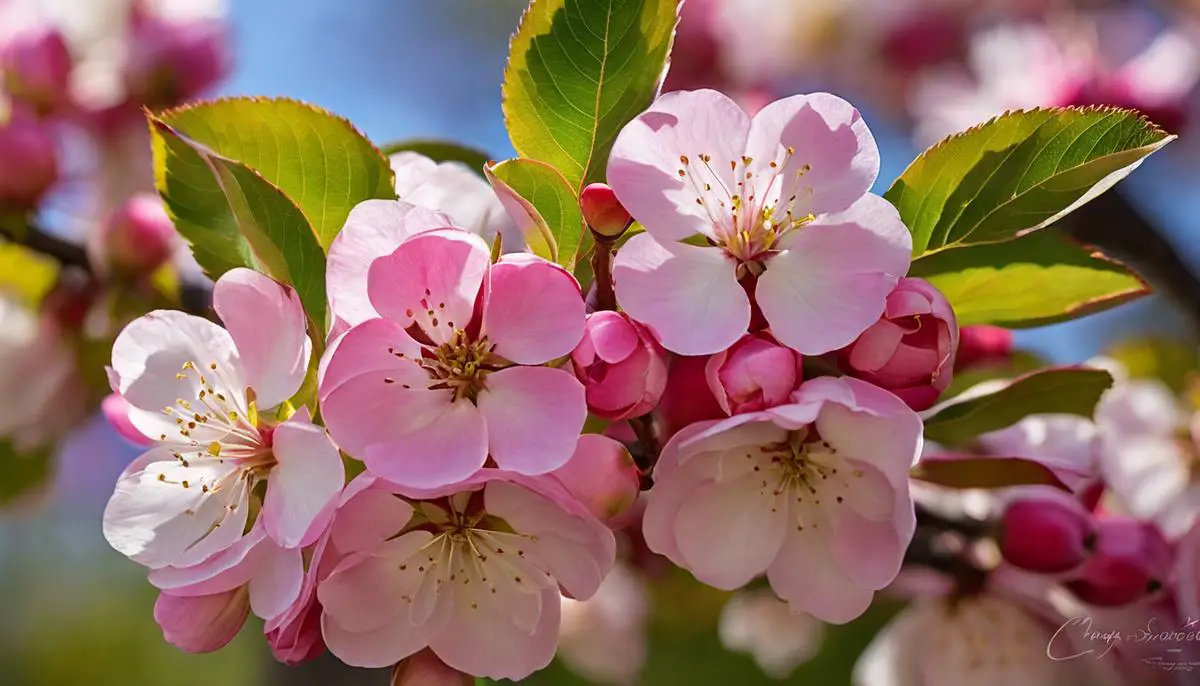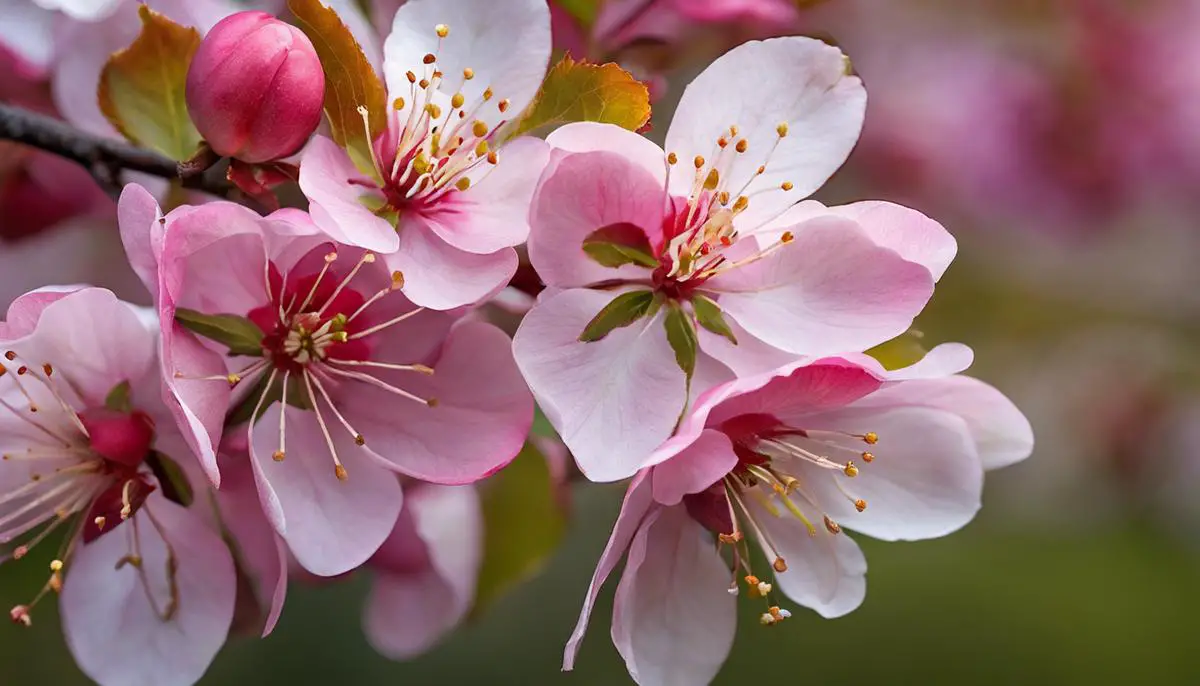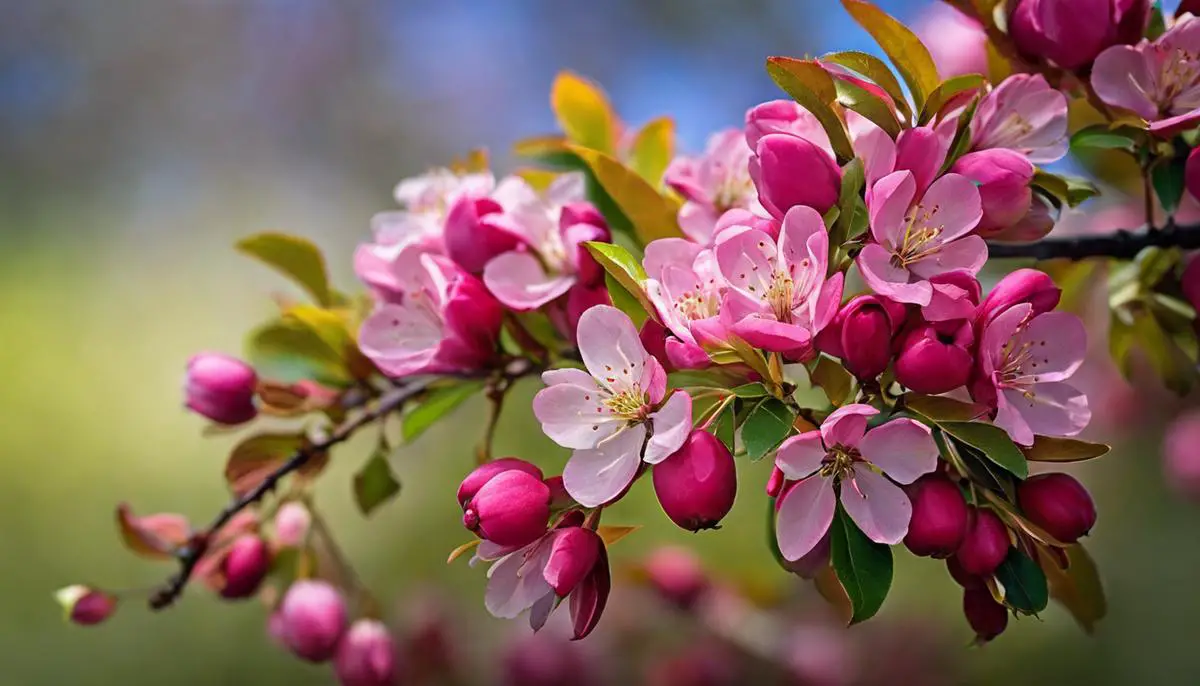The vibrancy and beauty of crab apple tree blooms are a sight to behold. Best known for their dramatic springtime display, these blossoms offer a wealth of color, fragrance, and form that are unrivaled in the plant kingdom. Backdropped by the season’s fresh greenery, they herald the arrival of warmer weather and longer days. This botanical spectacle, however, is not only for aesthetic purposes. As we delve into understanding the complexities of crab apple tree blooms, we come to appreciate its significance both ecologically and culturally.
Characteristics of Crab Apple Tree Blooms
The Enchanting Charms of Crab Apple Tree Blooms
As hobbyists, there’s a certain joy and thrill in discovering the unique and wonderful features of various flora and fauna. Today, let’s dive into the captivating world of crab apple tree blooms and uncover their fascinating attributes.
Crab apple trees, known scientifically as Malus species, are sustainers of an enchanting bloom season. Usually, these mesmerizing blossoms pop to life during mid-spring, creating a vibrant spectacle for all tree aficionados to admire and enjoy. Depending on the species, the bloom duration can last from a few days to a few weeks.
Their blooms are truly delightful and vary in shades from pure white to vivid pink. Some species even bloom with a tinge of red for an extra splash of color. Beautifully constituted, they consist of five petals typically, though some varieties may display a double-flower arrangement with additional petals that amplify their charm.
When speaking about size, crab apple blooms are a visual treat, though they’re not exceptionally large. That said, their charm lies not in their size but in their sheer volume. With so many blossoms clustered together on one tree, it creates a fantastic impression of being much larger than they are.
Deeper into the season, as the maturing bloom ages, subtle changes in color can occur, creating a fascinating shift from its initial hue. This unexpected surprise keeps onlookers captivated throughout the entire bloom cycle.
One surprising feature of crab apple tree blooms is their irresistible fragrance. More often than not, the scent is a sweet, almost fruity note, attracting not just people, but a horde of pollinators too, contributing significantly to local ecosystems.
Besides the charm of the bloom themselves, the crab apple tree’s overall aesthetic is also a thing of beauty. From the form of the tree, which greatly varies among species, from elegant weeping varieties to sturdy, upright forms, to the leaf colors that range from green to purple depending on the light intensity and season, everything is a sight to behold. Both before and after bloom seasons, the crab apple tree continues to intrigue with its attractive features.
So, there we have it – the captivating, enchanting, and utterly delightful features of crab apple tree blooms. From their mesmerizing shades to their sweet enticing scent, these blossoms not only add a spark to any environment but also significantly contribute to nurturing the biodiversity there. So, the next time you spot a crab apple tree in full bloom, take a moment to appreciate these amazing characteristics! It not only gives a feast for the eyes but also a gentle reminder of how rewarding our hobby, gardening, can be.

Caring for Crab Apple Tree Blooms
Taking care of your crab apple trees to encourage salutary and spectacular blossoms requires merely understanding their essential needs for growing. Remember, similar to any other plants, crab apple trees flourish when they’re accorded the right conditions and care.
First and foremost, you’ll want to choose an optimal place with excellent lighting conditions. Uncertainty may creep in, but worry not; these brilliant trees are adaptable and thrive in full sun to partial shade. However, they particularly flourish in full sun, being the secret ingredient in their stupendously vibrant blooms. As you select a spot, bear in mind that they need a well-drained soil. Ensuring that water doesn’t pool around their roots goes a long way in maintaining their health.
Planting or transplanting the crab apple trees requires a touch of green-loving care. Dig a hole twice as wide and the same depth as the root ball of your tree. Encourage root growth by mixing the soil from the hole with an organic matter such as garden compost or well-rotted manure. Then place the tree such that the top is even with the surrounding soil and fill the hole, firming the ground around the tree.
Proper hydration stands as a principal maxim in maintaining your crab apple trees. Especially during the first couple of years after planting, it’s vital to water the trees regularly. However, once established, they can be quite drought-tolerant. Although, in periods of extreme heat, a generous exception might be necessary.
Another key maintenance aspect is a good pruning habit. A timely trim, specifically in late winter or early spring, opens up the tree’s inner canopy to light and reduces susceptibility to diseases. Removal of damaged, dead, or diseased branches is also part of good practice. An open, airy middle can marvelously increase the tree’s capacity for succulent bloom production, while also improving the tree’s overall health.
Pest and disease prevention measures should be paramount to ensuring that your trees remain in prime condition, and that those lovely blooms gracing your yard are the envy of the neighborhood. Routinely examine for signs of pests and diseases. Crab apples are susceptible to common orchard diseases, such as apple scab and fire blight. When such challenges emerge, swift organic or even conventional treatments can make all the difference.
Finally, you may also consider adding a stream of nourishing delight for your trees. Crab apple trees can benefit from a balanced slow-release organic fertilizer applied in the early spring.
Reaping the beauty of a crab apple tree in full bloom is more than rewarding. It’s one of those little pleasures of life that help us appreciate the world around us. With just a bit of dedication and passion, you can undoubtedly relish the profuse beautiful flowers that crab apple trees bring to your landscape. As we have seen, they require minimal upkeep, and their adaptability makes them a perfect option for gardening enthusiasts of all skill levels. With a riot of color and a symphony of sweet scents in your yard, you just might find yourself spellbound by their allure.
We vouch, your passion and commitment for maintaining crab apple trees today, will nurture an exquisite spectacle for countless tomorrow. Happy gardening!

Types of Crab Apple Trees for Different Blooms
Heading into the world of crab apple trees is like taking a journey through an ever-changing landscape.
What makes this hobby even more enthralling is understanding and appreciating the distinct types of crab apple trees. These beautiful blossoms come in numerous forms, each one captivating in its own special way.
First on the list is the Malus ‘Adams’, a crab apple tree next to none.
Known for tennis ball-sized fruit, the ‘Adams’ features a stunning display of red-pink flowers that illuminate the garden in all their glory. Not just for the eyes, the large, shiny red fruit provides a treat for the birds too.
“How about another red, but with a twist?” you might ask. Well, the world of crab apple trees doesn’t disappoint. The Malus ‘Centurion’ flaunts red buds that unfold into luscious crimson-pink blooms. The bright-red fruit that follows offers a striking contrast to its glossy green leaves, keeping your garden cheerful from spring all the way to fall.
The Malus ‘Donald Wyman’ offers a charming change of color. Ever appreciated for delicate white blooms, this tree leaves a soft and serene impression. As the season progresses, the flowers give way to glossy, red fruit that serves as a delicacy for birds. With its striking red-berry spectacle in winter, this tree is a year-round delight.
If you’re looking for something with the essence of a golden hour sky, the Malus ‘Golden Hornet’ could be a match made in heaven. It welcomes the spring with a blaze of white blooms and follows through into fall with an exciting show of luminous golden-yellow fruit. Truly breathtaking!
In the world of small-sized crab apple trees, look no further than the Malus sargentii. Despite its petite size, this hardy little tree knows how to put on a show. Every May, it’s cloaked in a profusion of snowy white blooms that make this gem stand out.
No tour of crab apple trees would be complete without mentioning the Malus ‘Coralburst’. Compact and uniquely shaped, the large double pink flowers of this tree open from dark pink buds, offering a sweet color play.
Last, but certainly not least, the Malus ‘Profusion’, living up to its name, blooms a profusion of deep wine-red flowers, later presenting small, maroon colored fruits.
Each species has its own unique flare, presenting hobbyists with a splendid rainbow of shades and shapes. The wonders of crab apple trees are many, but their ability to transform a modest garden into an all-season showroom is utterly magical! Now imagine, your own fjord, blush, or snow-touched garden, becoming the home of these enchanting trees. The possibilities are endless!
Sow them, water them, and prune them not just with your hands, but with your heart. Watch your efforts bear fruit, quite literally, and enjoy the scenic beauty they bring to your doorstep. Above all, continue to learn, explore, and discover. After all, every crab apple tree has its tale to tell, an adventure waiting to unfold. So, let’s dive in, shall we? Who knows what we’ll find next in this wonderful world of crab apple trees!

Uses and Benefits of Crab Apple Tree Blooms
As the crab apple tree, with its beautiful array of blossoming colors, finally reaches bloom season, a transformative experience for their surroundings commence. In a harmonizing symphony of nature, these robust and adaptable trees bring more than just visual charm to an environment. Unknown to many, the blooms of these trees work in more ways than one for their surroundings.
The blooms of crab apple trees significantly enhance the environmental aesthetics. They can be your garden’s crowning glory, showcasing a vibrant spectacle that lights up space. The beaming blooms, besides alluding spring’s arrival, can serve as a centerpiece in a garden or park, capturing the attention and admiration of anyone who lays eyes on them. The stark contrast that forms between the vivid petals and the tree’s green foliage can create a dreamy atmosphere that transcends into an artist’s canvas.
But there’s more! Not only are the blooms visually pleasing, but they have functional roles too. The beautiful blooms of the crab apple tree also work as a valuable source of pollen and nectar for a wide array of pollinators, including bees, butterflies, and birds. When in full bloom, these trees can lure myriad species of wildlife, thereby enriching local biodiversity. They play a pivotal role in any given ecosystem, facilitating a chain reaction within the food chain that aids in promoting biodiversity within the area.
Relaxing in your garden, watching and listening to the wildlife visitors, is a source of joy and mindfulness that further elevates the aesthetic value of the tree.
From a practical perspective, the crab apple tree blooms can be harvested and used in various applications as well. These tangy fruits may be small, but they pack a punch in the culinary world. The fruit is high in pectin, which makes it perfect for jam and jelly making. Consider hosting a crab apple harvest day – it’s a chance to share the passion for these trees, inviting friends and neighbors to gather the fruit and, perhaps, share a pot of homemade crab apple jelly afterward.
In addition, the crab apple tree blooms can also be used medicinally. Known for their health benefits ever since ancient times, these blooms can be used in making traditional remedies, essential oils, and herbal teas – allowing hobbyists to healthily immerse themselves in the beauty and utility that these trees provide.
As a finale, these resilient and hardy trees often prove to be a great starter tree for many aspiring gardeners, they are an all-around solid choice when making a selection for a new addition to your green space.
So next time when observing the splendid display of a crab apple tree in full bloom, remember, it’s not just a visual spectacle, but a nature’s magician that has a cast of functional roles with beneficial ripple effects on its surroundings. Be motivated and inspired by this multifaceted beauty and continue to cultivate plant knowledge and nature appreciation. It’s more than a hobby; it’s being a participant in the beautiful cycle of life!

After acquainting ourselves with the unique characteristics and variations of crab apple tree blooms, it’s clear these trees are fascinating beyond their striking beauty. Careful and proper nurturing can lead to healthier trees and even more spectacular blooms. Beyond their ornamental role, they serve as an important link in our ecosystem, providing necessary sustenance for various wildlife species, aiding in pollination, and providing us practical and medicinal benefits. These all-encompassing features lend a certain enchantment to crab apple tree blooms, making them a favorite among plant enthusiasts and a staple in our landscapes.